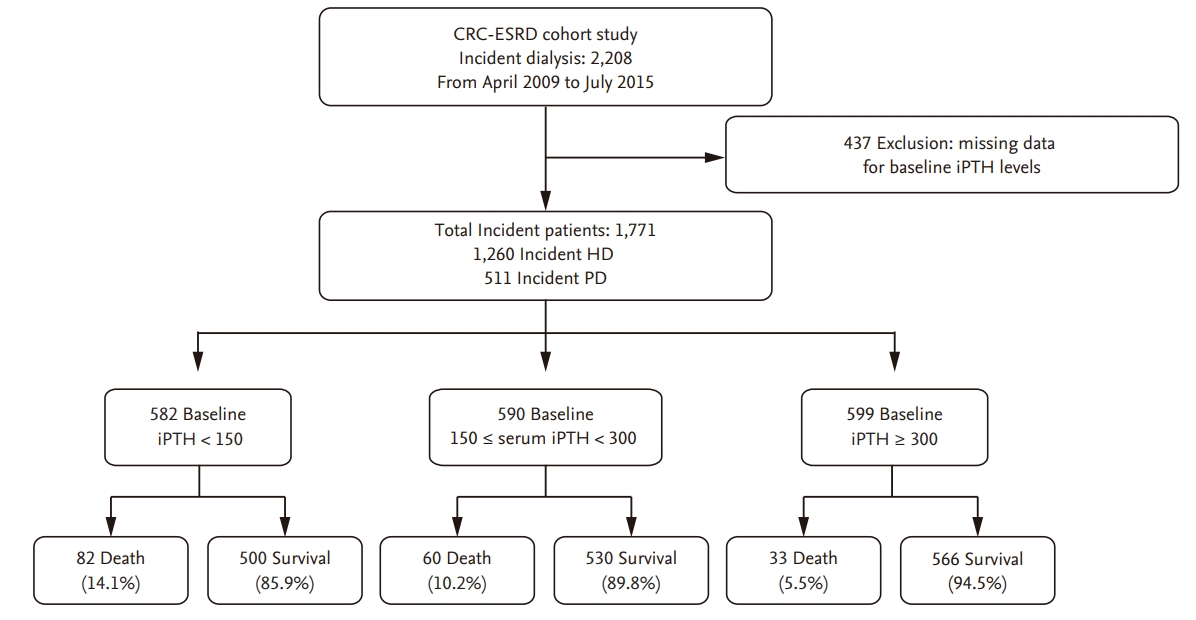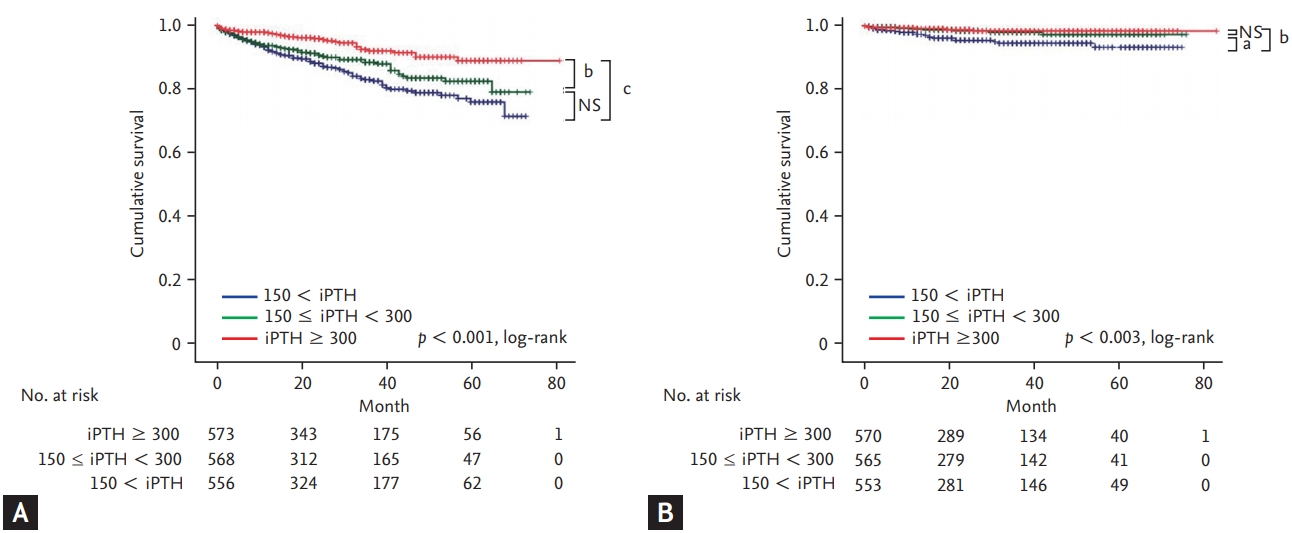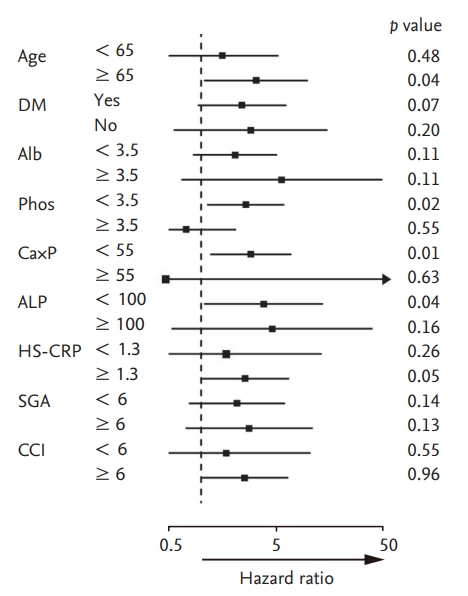1. Block GA, Klassen PS, Lazarus JM, Ofsthun N, Lowrie EG, Chertow GM. Mineral metabolism, mortality, and morbidity in maintenance hemodialysis. J Am Soc Nephrol 2004;15:2208ŌĆō2218.


2. Kimata N, Albert JM, Akiba T, et al. Association of mineral metabolism factors with all-cause and cardiovascular mortality in hemodialysis patients: the Japan dialysis outcomes and practice patterns study. Hemodial Int 2007;11:340ŌĆō348.


3. Young EW, Albert JM, Satayathum S, et al. Predictors and consequences of altered mineral metabolism: the Dialysis Outcomes and Practice Patterns Study. Kidney Int 2005;67:1179ŌĆō1187.


6. Avram MM, Mittman N, Myint MM, Fein P. Importance of low serum intact parathyroid hormone as a predictor of mortality in hemodialysis and peritoneal dialysis patients: 14 years of prospective observation. Am J Kidney Dis 2001;38:1351ŌĆō1357.


7. Sarnak MJ, Jaber BL. Mortality caused by sepsis in patients with end-stage renal disease compared with the general population. Kidney Int 2000;58:1758ŌĆō1764.


8. Alexiewicz JM, Smogorzewski M, Fadda GZ, Massry SG. Impaired phagocytosis in dialysis patients: studies on mechanisms. Am J Nephrol 1991;11:102ŌĆō111.


9. Perry HM 3rd, Chappel JC, Bellorin-Font E, Tamao J, Martin KJ, Teitelbaum SL. Parathyroid hormone receptors in circulating human mononuclear leukocytes. J Biol Chem 1984;259:5531ŌĆō5535.


11. National Kidney Foundation. K/DOQI clinical practice guidelines for bone metabolism and disease in chronic kidney disease. Am J Kidney Dis 2003;42(4 Suppl 3):S1ŌĆōS201.

16. Wald R, Sarnak MJ, Tighiouart H, et al. Disordered mineral metabolism in hemodialysis patients: an analysis of cumulative effects in the hemodialysis (HEMO) Study. Am J Kidney Dis 2008;52:531ŌĆō540.


17. Klinger M, Alexiewicz JM, Linker-Israeli M, et al. Effect of parathyroid hormone on human T cell activation. Kidney Int 1990;37:1543ŌĆō1551.


18. Lewin E, Ladefoged J, Brandi L, Olgaard K. Parathyroid hormone dependent T cell proliferation in uremic rats. Kidney Int 1993;44:379ŌĆō384.


19. Ozdemir FN, Yakupoglu U, Turan M, et al. Role of parathormone levels on T-cell response in hemodialysis patients. Transplant Proc 2002;34:2044ŌĆō2045.


21. Fukagawa M, Akizawa T, Kurokawa K. Is aplastic osteodystrophy a disease of malnutrition? Curr Opin Nephrol Hypertens 2000;9:363ŌĆō367.


23. Nielsen PK, Rasmussen AK, Butters R, et al. Inhibition of PTH secretion by interleukin-1 beta in bovine parathyroid glands in vitro is associated with an up-regulation of the calcium-sensing receptor mRNA. Biochem Biophys Res Commun 1997;238:880ŌĆō885.


24. Kalantar-Zadeh K, Kuwae N, Regidor DL, et al. Survival predictability of time-varying indicators of bone disease in maintenance hemodialysis patients. Kidney Int 2006;70:771ŌĆō780.


25. Blayney MJ, Pisoni RL, Bragg-Gresham JL, et al. High alkaline phosphatase levels in hemodialysis patients are associated with higher risk of hospitalization and death. Kidney Int 2008;74:655ŌĆō663.


27. Kalantar-Zadeh K, Shah A, Duong U, Hechter RC, Dukkipati R, Kovesdy CP. Kidney bone disease and mortality in CKD: revisiting the role of vitamin D, calcimimetics, alkaline phosphatase, and minerals. Kidney Int Suppl 2010;117:S10ŌĆōS21.

28. Bover J, Urena P, Brandenburg V, et al. Adynamic bone disease: from bone to vessels in chronic kidney disease. Semin Nephrol 2014;34:626ŌĆō640.


29. Heaf J. Adynamic bone disease and malnutrition-inflammation-cachexia syndrome. Kidney Int 2007;71:1326.










 PDF Links
PDF Links PubReader
PubReader ePub Link
ePub Link Full text via DOI
Full text via DOI Download Citation
Download Citation Supplement 1
Supplement 1 Print
Print



